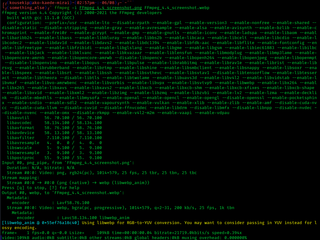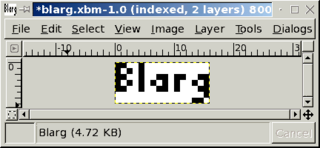
The Graphics Interchange Format is a bitmap image format that was developed by a team at the online services provider CompuServe led by American computer scientist Steve Wilhite and released on June 15, 1987.

MP3 is a coding format for digital audio developed largely by the Fraunhofer Society in Germany under the lead of Karlheinz Brandenburg, with support from other digital scientists in other countries. Originally defined as the third audio format of the MPEG-1 standard, it was retained and further extended — defining additional bit-rates and support for more audio channels — as the third audio format of the subsequent MPEG-2 standard. A third version, known as MPEG-2.5 — extended to better support lower bit rates — is commonly implemented, but is not a recognized standard.

MPEG-2 is a standard for "the generic coding of moving pictures and associated audio information". It describes a combination of lossy video compression and lossy audio data compression methods, which permit storage and transmission of movies using currently available storage media and transmission bandwidth. While MPEG-2 is not as efficient as newer standards such as H.264/AVC and H.265/HEVC, backwards compatibility with existing hardware and software means it is still widely used, for example in over-the-air digital television broadcasting and in the DVD-Video standard.
PCX, standing for PiCture eXchange, was an image file format developed by the now-defunct ZSoft Corporation of Marietta, Georgia, United States. It was the native file format for PC Paintbrush and became one of the first widely accepted DOS imaging standards, although it has since been succeeded by more sophisticated image formats, such as BMP, JPEG, and PNG. PCX files commonly stored palette-indexed images ranging from 2 or 4 colors to 16 and 256 colors, although the format has been extended to record true-color (24-bit) images as well.
Windows Media Audio (WMA) is a series of audio codecs and their corresponding audio coding formats developed by Microsoft. It is a proprietary technology that forms part of the Windows Media framework. WMA consists of four distinct codecs. The original WMA codec, known simply as WMA, was conceived as a competitor to the popular MP3 and RealAudio codecs. WMA Pro, a newer and more advanced codec, supports multichannel and high resolution audio. A lossless codec, WMA Lossless, compresses audio data without loss of audio fidelity. WMA Voice, targeted at voice content, applies compression using a range of low bit rates. Microsoft has also developed a digital container format called Advanced Systems Format to store audio encoded by WMA.

FFmpeg is a free and open-source software project consisting of a suite of libraries and programs for handling video, audio, and other multimedia files and streams. At its core is the command-line ffmpeg tool itself, designed for processing of video and audio files. It is widely used for format transcoding, basic editing, video scaling, video post-production effects and standards compliance.
Advanced Audio Coding (AAC) is an audio coding standard for lossy digital audio compression. Designed to be the successor of the MP3 format, AAC generally achieves higher sound quality than MP3 encoders at the same bit rate.
The BMP file format or bitmap, is a raster graphics image file format used to store bitmap digital images, independently of the display device, especially on Microsoft Windows and OS/2 operating systems.

Smacker video is a video file format developed by Epic Games Tools, and primarily used for full-motion video in video games. Smacker uses an adaptive 8-bit RGB palette. RAD's format for video at higher color depths is Bink Video. The Smacker format specifies a container format, a video compression format, and an audio compression format. Since its release in 1994, Smacker has been used in over 2300 games. Blizzard used this format for the cinematic videos seen in its games Warcraft II, StarCraft and Diablo I.
QuickTime Animation format is a video compression format and codec created by Apple Computer to enable playback of RGB video in real time without expensive hardware. It is generally found in the QuickTime container with the FourCC 'rle '. It can perform either lossless or lossy compression and is one of the few video codecs that supports an alpha channel. Supported color depths are 1-bit (monochrome), 15-bit RGB, 24-bit RGB, 32-bit ARGB, as well as palettized RGB. As a result of reverse-engineering of the format, a decoder is implemented in XAnim as well as an encoder and decoder in libavcodec.

In computer graphics, the X Window System used X BitMap (XBM), a plain text binary image format, for storing cursor and icon bitmaps used in the X GUI. The XBM format is superseded by XPM, which first appeared for X11 in 1989.

Indeo Video is a family of audio and video formats and codecs first released in 1992, and designed for real-time video playback on desktop CPUs. While its original version was related to Intel's DVI video stream format, a hardware-only codec for the compression of television-quality video onto compact discs, Indeo was distinguished by being one of the first codecs allowing full-speed video playback without using hardware acceleration. Also unlike Cinepak and TrueMotion S, the compression used the same Y'CbCr 4:2:0 colorspace as the ITU's H.261 and ISO's MPEG-1. Indeo use was free of charge to allow for broadest usage.
Flash Video is a container file format used to deliver digital video content over the Internet using Adobe Flash Player version 6 and newer. Flash Video content may also be embedded within SWF files. There are two different Flash Video file formats: FLV and F4V. The audio and video data within FLV files are encoded in the same way as SWF files. The F4V file format is based on the ISO base media file format, starting with Flash Player 9 update 3. Both formats are supported in Adobe Flash Player and developed by Adobe Systems. FLV was originally developed by Macromedia. In the early 2000s, Flash Video was the de facto standard for web-based streaming video. Users include Hulu, VEVO, Yahoo! Video, metacafe, Reuters.com, and many other news providers.

The loosely defined category of S1 MP3 players is comprised by a large amount of then-inexpensive handheld digital audio players. The players were mainly widespread around 2005–2006 but the series continued for years afterwards, blurring into that of so-called "MP4 players" employing S1 and competing architectures.
Media Foundation (MF) is a COM-based multimedia framework pipeline and infrastructure platform for digital media in Windows Vista, Windows 7, Windows 8, Windows 8.1, Windows 10, and Windows 11. It is the intended replacement for Microsoft DirectShow, Windows Media SDK, DirectX Media Objects (DMOs) and all other so-called "legacy" multimedia APIs such as Audio Compression Manager (ACM) and Video for Windows (VfW). The existing DirectShow technology is intended to be replaced by Media Foundation step-by-step, starting with a few features. For some time there will be a co-existence of Media Foundation and DirectShow. Media Foundation will not be available for previous Windows versions, including Windows XP.
Asao is a proprietary single-channel (mono) codec and compression format optimized for low-bitrate transmission of audio, developed by Nellymoser Inc.

WebP is a raster graphics file format developed by Google intended as a replacement for JPEG, PNG, and GIF file formats. It supports both lossy and lossless compression, as well as animation and alpha transparency.

Opus is a lossy audio coding format developed by the Xiph.Org Foundation and standardized by the Internet Engineering Task Force, designed to efficiently code speech and general audio in a single format, while remaining low-latency enough for real-time interactive communication and low-complexity enough for low-end embedded processors. Opus replaces both Vorbis and Speex for new applications, and several blind listening tests have ranked it higher-quality than any other standard audio format at any given bitrate until transparency is reached, including MP3, AAC, and HE-AAC.

VP9 is an open and royalty-free video coding format developed by Google.
The Quite OK Image Format (QOI) is a specification for lossless image compression of 24-bit or 32-bit color raster (bitmapped) images, invented by Dominic Szablewski and first announced on 24 November 2021.










